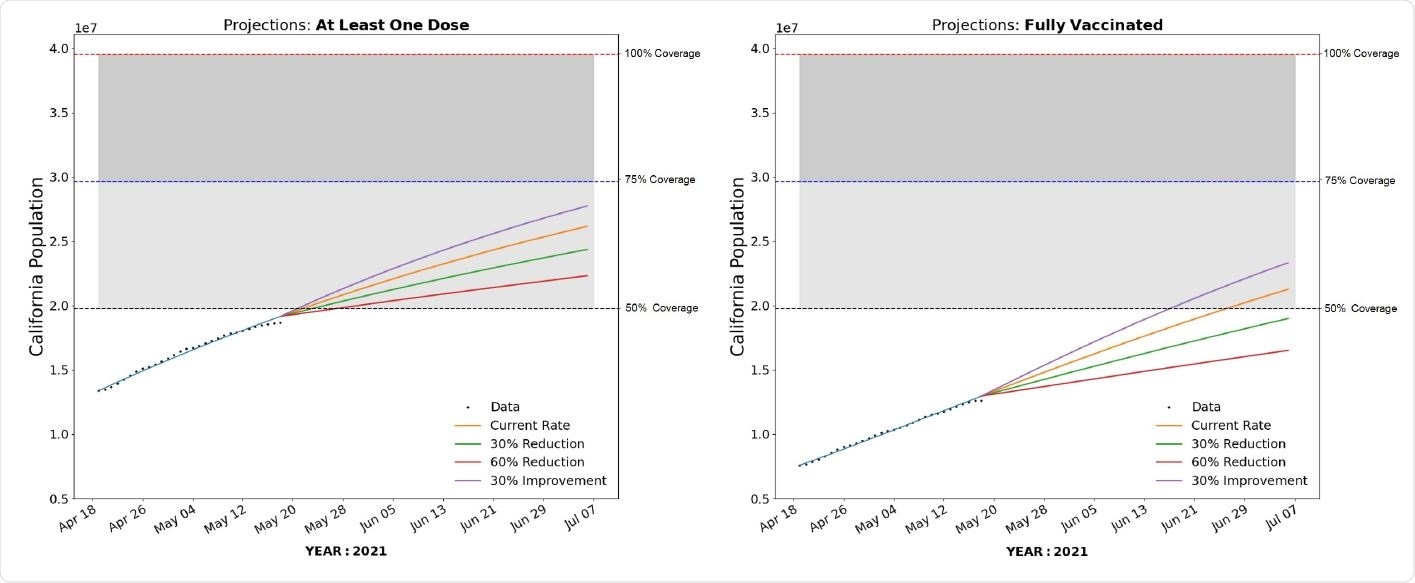As of March 2021, California had one of the least equitable vaccine distribution programs for COVID-19 in the US. To address this, Governor Newsom ordered that 40% of California’s vaccine supply be reserved for the census tracts in the lowest quartile of the Healthy Places Index (HPI).
California is planning to lift all state-wide restrictions and fully open on 15 June, 2021 using four primary indicators to assess readiness: 1. county-wide adjusted daily case rates, 2. county-wide test positivity rates, 3. health equity measurement based on test positivity rates in the lowest-quartile HPI tracts, and 4. vaccine equity measurement based on total vaccinations in the state’s most vulnerable neighborhoods.

 This news article was a review of a preliminary scientific report that had not undergone peer-review at the time of publication. Since its initial publication, the scientific report has now been peer reviewed and accepted for publication in a Scientific Journal. Links to the preliminary and peer-reviewed reports are available in the Sources section at the bottom of this article. View Sources
This news article was a review of a preliminary scientific report that had not undergone peer-review at the time of publication. Since its initial publication, the scientific report has now been peer reviewed and accepted for publication in a Scientific Journal. Links to the preliminary and peer-reviewed reports are available in the Sources section at the bottom of this article. View Sources
Examining vaccine equity and vaccine coverage forecasts in California in various scenarios
Researchers from the University of California, Davis recently conducted a short investigation to examine current vaccine equity and forecasts of vaccine coverage in California by June 15, 2020, in various scenarios. This study is published on the preprint server, medRxiv*.
The researchers collected HPI data for individual census tracts from the Public Health Alliance of California and single-dose and full-dose vaccination rates for each county from the California Department of Public Health. They investigated current vaccine equity using simple linear regression between the county mean HPI and single and 2-dose vaccination rates. They also predicted future vaccination coverage per county with the help of a compartmental mathematical model based on the 30-day average rate with 4 different rate-change scenarios.
Results show that at the current vaccination rate, over 50% of the population will be fully vaccinated by June 15
The study results showed a strong positive association between the county mean HPI and both the single and full dose vaccination rates. Counties in the San Joaquin Valley region had steadily low HPI values and vaccination rates.
The observations predict that 66.2% of the state population will have at least a single dose of the vaccine and 53.8% will be fully vaccinated by June 15 provided the current rates are maintained. However, the model predictions have some disparities when broken down by county, as only 18 out of 58 counties are expected to reach or exceed a 50% fully vaccinated rate by June 15.
“Of the eight counties (San Joaquin, Stanislaus, Merced, Madera, Fresno, Kings, Tulare, and Kern), seven are in the lowest quartile for county mean HPI, and Fresno currently leads the fully vaccinated rate among them at 31%.”

Statewide predictions from the simple compartmental model.
Vaccine hesitancy due to social and demographic factors is the reason for insufficient vaccination rates
According to the authors, a clear association between county HPI and vaccination rates shows that California has no equitable foundation to initiate opening plans, despite previous equity programs. Although when observed as an entire state, California may be in an optimistic position for lifting restrictions in June 2021, the success is largely restricted to urban centers and is not homogenous across the state. The least vaccinated counties are also the ones with the most vulnerable populations.
Vaccine hesitancy driven by social and demographic factors is cited as a major reason for the state not achieving adequate vaccination rates. According to a vaccine hesitancy survey, the temporary pause of the Janssen COVID-19 vaccine led to hesitancy in 39% of unvaccinated Hispanic women.
If nothing changes with respect to vaccination rates, many of the vulnerable counties may not be ready to open without consequences by June 15. The authors recommend closer, more sophisticated examinations in order to characterize the various leading to larger-scale inequities in vaccination.
“This simple study’s use of an aggregate vulnerability index likely obscures how different aspects of vulnerability have led to inequities across the state.”

 This news article was a review of a preliminary scientific report that had not undergone peer-review at the time of publication. Since its initial publication, the scientific report has now been peer reviewed and accepted for publication in a Scientific Journal. Links to the preliminary and peer-reviewed reports are available in the Sources section at the bottom of this article. View Sources
This news article was a review of a preliminary scientific report that had not undergone peer-review at the time of publication. Since its initial publication, the scientific report has now been peer reviewed and accepted for publication in a Scientific Journal. Links to the preliminary and peer-reviewed reports are available in the Sources section at the bottom of this article. View Sources
Journal references:
- Preliminary scientific report.
COVID-19 Vaccination in California: Are We Equitable Yet? Alec J. Schmidt, Maria L. Daza–Torres, Yury E. García, Joan L. Ashby, Bradley H. Pollock, James Sharpnack, Miriam Nuño medRxiv 2021.05.25.21257807; doi: https://doi.org/10.1101/2021.05.25.21257807, https://www.medrxiv.org/content/10.1101/2021.05.25.21257807v1
- Peer reviewed and published scientific report.
Daza–Torres, Maria L., Yury E. García, Alec J. Schmidt, Brad H. Pollock, James Sharpnack, and Miriam Nuño. 2022. “The Impact of COVID-19 Vaccination on California’s Return to Normalcy.” Edited by Charles Shey Wiysonge. PLOS ONE 17 (5): e0264195. https://doi.org/10.1371/journal.pone.0264195. https://journals.plos.org/plosone/article?id=10.1371/journal.pone.0264195.
Article Revisions
- Apr 8 2023 - The preprint preliminary research paper that this article was based upon was accepted for publication in a peer-reviewed Scientific Journal. This article was edited accordingly to include a link to the final peer-reviewed paper, now shown in the sources section.